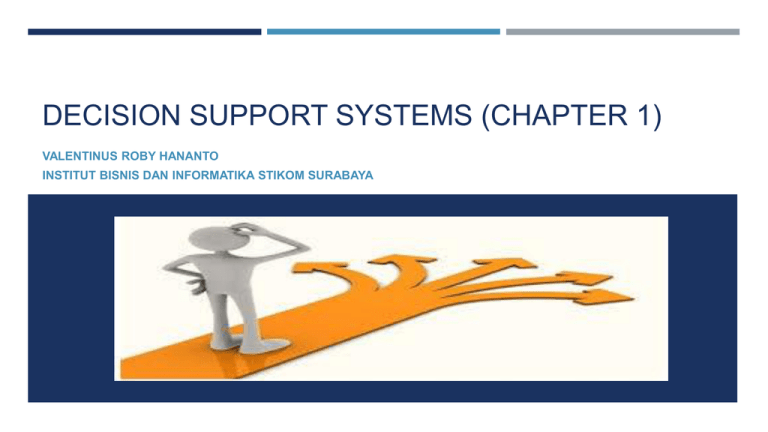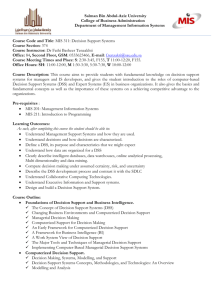decision support systems (chapter 1)
advertisement

DECISION SUPPORT SYSTEMS (CHAPTER 1) VALENTINUS ROBY HANANTO INSTITUT BISNIS DAN INFORMATIKA STIKOM SURABAYA LEARNING OUTCOME Mahasiswa mampu memahami dan menjelaskan tentang: pengambilan keputusan, keputusan manajerial dan sistem informasi, pentingnya dukungan komputer, keputusan terkomputerisasi dan kerangka kerja pendukung keputusan LEVELS OF ORGANIZATION OPERATIONAL LEVEL MANAGERIAL LEVEL EXECUTIVE LEVEL ORGANIZATIONAL BOUNDARIES MANAGEMENT SUPPORT SYSTEMS AN OVERVIEW Emerging and Advanced Computer Technologies for Supporting Managerial Problem Solution Changing Organizational Structure Enabling Business Transformation Changing Management Methods BUSINESS PRESSURES – RESPONSES – SUPPORT MODEL DSS DEFINITION Decision support system (DSS) are used to make business decision often based on data collected by On-Line-Analytical-Processing system (OLAP) Example of data used for making decision : Retail sales transaction detail DSS as an Umbrella term: Describes any computerized system that supports decision making in an organization 10 Decision Support and Business Intelligence Systems, Eighth Edition WHY USE OF DSS Why use decision support systems? Speedy computations Improved communication and collaboration Increased productivity of group members Improved data management Managing giant data warehouses Quality support Overcoming cognitive limits in processing and storing information Anywhere, anytime support 11 Decision Support and Business Intelligence Systems, Eighth Edition DECISION MAKING AND MANAGEMENT Management is a process by which organizational goals are achieved through the use of resources (people, money, energy, materials, space, time). These resources are considered to be inputs, and the attainment of the goals is viewed as the output of the process. Measuring success: Productivity= output/input Management is decision making The manager is decsion maker 12 Decision Support and Business Intelligence Systems, Eighth Edition DECISION MAKING AND MANAGEMENT (CONT.) The nature of managers’ work Interpersonal : figurehead, leader, liaison. Informational: monitor, disseminator, spokesperson. Decisional: entrepreneur, disturbance handler, resource allocator, negotiator. 13 Decision Support and Business Intelligence Systems, Eighth Edition DECISION MAKING AND MANAGEMENT (CONT.) Why Managers Need IT Support processing information manually is growing increasingly difficult computerized modeling examining numerous alternatives very quickly providing a systematic risk analysis being integrated with communication systems and databases being used to support group work 14 Decision Support and Business Intelligence Systems, Eighth Edition PHASES OF THE DECISION MAKING REALITY Examination Intelligence Phase Verification of the Model Design Phase Verification, Testing of Proposed Solution Choice Phases SUCCESS Implementation of Solution FAILURE Decision Support and Business Intelligence Systems, Eighth Edition PHASES OF THE DECISION MAKING (CONT.) Intelligence phase Organizational objectives Search and scanning procedures Data collection Problem identification Problem classification Problem statement Result: Reality is examined The problem is identified and defined 16 Decision Support and Business Intelligence Systems, Eighth Edition PHASES OF THE DECISION MAKING(CONT.) Design phase Formulate a model (Assumption) Set criteria for choice Search for alternative Predict and measure outcomes Result: Representative model is constructed The model is validated and evaluation criteria are set 17 Decision Support and Business Intelligence Systems, Eighth Edition PHASES OF THE DECISION MAKING(CONT.) Choice phase solution to the model Sensitivity analysis Selection of Best (Good) alternative Plan for implementation Design of control system Result: Proposed solution is included to the model If reasonable, move to implementation phase. 18 Decision Support and Business Intelligence Systems, Eighth Edition PHASES OF THE DECISION MAKING(CONT.) Implementation phase Put solution into action Result: Solution to the original problem 19 Decision Support and Business Intelligence Systems, Eighth Edition DECISION MAKING PROCESSES 20 The process of decision making 1. Defining the problem (i.e., a decision situation that may deal with some difficulty or with an opportunity) 2. Constructing a model that describes the real-world problem 3. Identifying possible solutions to the modeled problem and evaluating the solutions 4. Comparing, choosing, and recommending a potential solution to the problem Decision Support and Business Intelligence Systems, Eighth Edition DECISION MAKERS: WHO ARE THEY? Decision maker classification Individual decision makers can be single person or a computer system Multiple decision makers can be: Team where members support a single decision maker Groups where all members have a say in the decision Organization where global agreement is needed. 21 Decision Support and Business Intelligence Systems, Eighth Edition FRAMEWORK FOR COMPUTERIZED DECISION SUPPORT Type of Control Type of Decision Structured Semi-structured Unstructured 22 Support Needed Operational Control Managerial Control Strategic Planning Accounts 1 Receivable Order entry Budget analysis, 2 short-term forecasting, personnel reports, make-ofbuy analysis Financial 3 management , warehouse location, distribution systems Production 4 scheduling inventory control Credit evaluation, Budget 5 Preparation, plan layout, project scheduling, rewarded systems design Building new plant, mergers and6 acquisitions, new product planning, compensation planning, quality assurance planning Selecting a cover 7 for a magazine, buying software approving loans Negotiating, recruiting and executive, buying hardware, lobbying R & D planning, new 9 technology development social responsibility planning MIS, MS MS, DSS, EIS, ES 8 Support Needed MIS MS models F & S models DSS DSS ES Neural Networks EIS, ES, Neural Networks Decision Support and Business Intelligence Systems, Eighth Edition FRAMEWORK FOR COMPUTERIZED DECISION SUPPORT (CONT.) Three type of decision : 1- Structured problems: are routine problems for which standard solution method exist. Procedure for obtaining the best solution are known Objective are clearly defined 2- Unstructured problems: are fuzzy, complex problem for which there are no cut-and direct solution methods. Have no structure phase Often solved with human intuition 3- Semi-structured problem: is a decision problem in which some but not all phases are structured. In between solve with standard solution procedure and human judgment 23 Decision Support and Business Intelligence Systems, Eighth Edition FRAMEWORK FOR COMPUTERIZED DECISION SUPPORT (CONT.) The decision support matrix For semistructured decisions and unstructured decisions, conventional MIS and MS tools are insufficient ; BUT Decision support systems (DSS) are used. Computer support for structured decisions Management science (MS) or operations research (OR) are used . Automated decision systems (ADS) is used. 24 Decision Support and Business Intelligence Systems, Eighth Edition FRAMEWORK FOR COMPUTERIZED DECISION SUPPORT (CONT.) Management science (MS) or operations research (OR) The application of a scientific approach and mathematical models to the analysis and solution of managerial decision situations (e.g., problems, opportunities) It adds new step 2 to the process of decision making, that is classify the problem into standard category. Automated decision systems (ADS) A business rules-based system that uses intelligence to recommend solutions to repetitive decisions (such as pricing) 25 Decision Support and Business Intelligence Systems, Eighth Edition ARCHITECTURE OF A DECISION SYSTEM 26 Decision Support and Business Intelligence Systems, Eighth Edition ARCHITECTURE OF A DECISION SYSTEM(CONT.) The architecture of DSS Data Models manipulate data as related to a specific situation Knowledge component User interface * The user themselves are also important components of the architecture 27 Decision Support and Business Intelligence Systems, Eighth Edition DECISION ANALYSIS Decision analysis allow us to select a decision from set of possible decision alternatives when uncertainties regarding the future exist. The goal is to optimize the resulting return (payoff) in term of decision criteria. 28 Decision Support and Business Intelligence Systems, Eighth Edition DSS AND DATA WAREHOUSE Data warehouse is a decision support database. The data warehouse is an integrated, subject-oriented, time-variant, non- volatile database that provide support for decision making. 29 Decision Support and Business Intelligence Systems, Eighth Edition DSS AND DATA WAREHOUSE Integrated: the data warehouse is centralized, consolidated database that integrates data retrieved from the entire organization. Subject- oriented: data of data warehouse is arranged and optimized to provide answer to questions coming from diverse functional area within a company. Time-variant: the data warehouse represent the flow of data through time Non-volatile: once data enter the data warehouse, they are never removed. 30 Decision Support and Business Intelligence Systems, Eighth Edition ON-LINE ANALYTICAL PROCESSING (OLAP) It is an element of DSS. It is support ad-hoc querying for business analyst. Multidimensional view of data is foundation of OLAP Multidimensional data 31 Decision Support and Business Intelligence Systems, Eighth Edition DSS AREA DSS EIP Management Science ERM Business Analytics ERP Data Mining CRM Data Warehouse SCM Business Intelligence KMS OLAP KMP CASE tools ES GIS ANN EIS Intelligent Agents TASK # 1 Each group have to present one case study; under these conditions: define organization Define business problem Provide possible solutions The result. 33 Decision Support and Business Intelligence Systems, Eighth Edition





